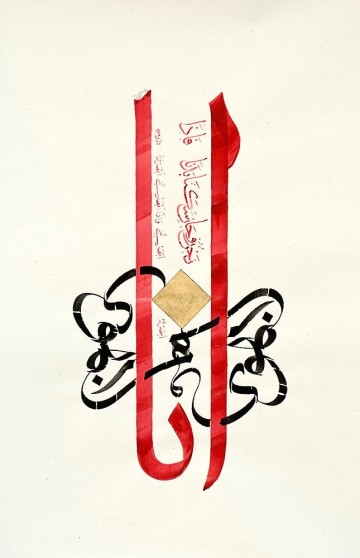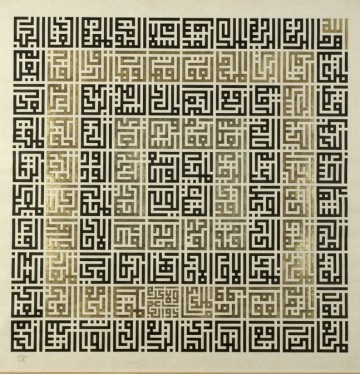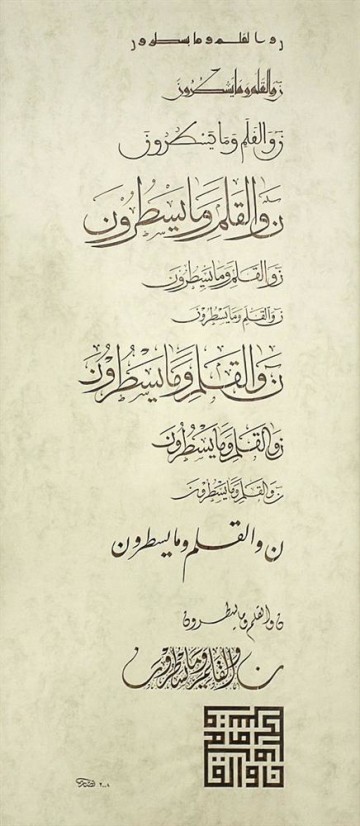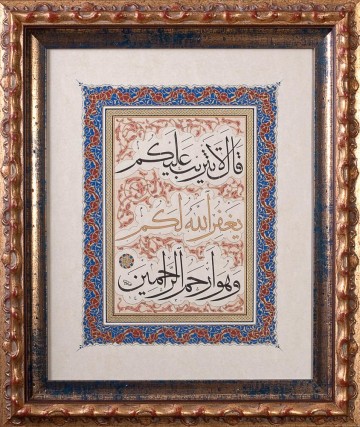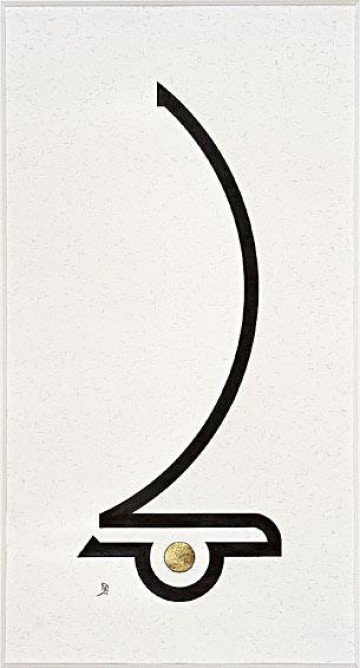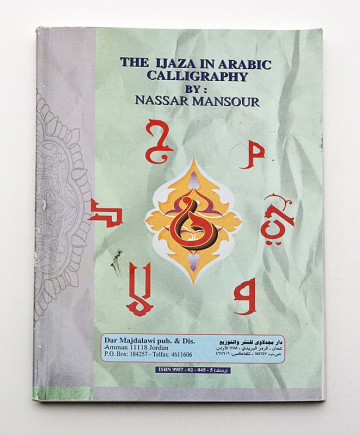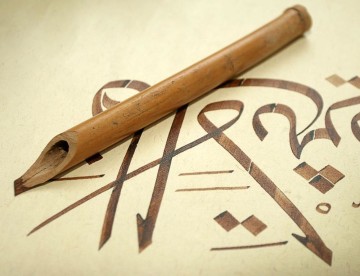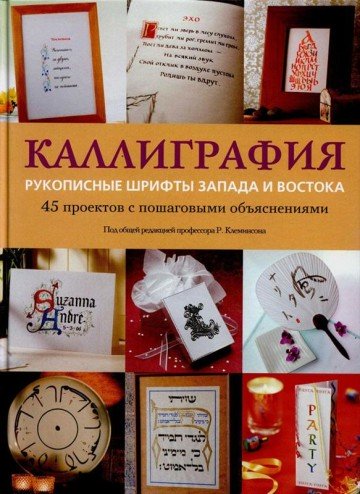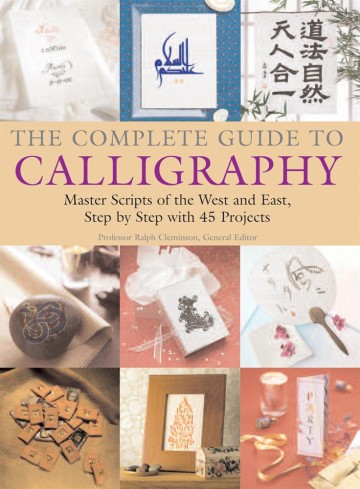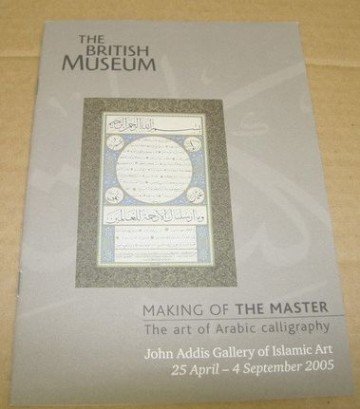Nassar Mansour

Nassar Mansour
Amman, Jordan
Calligrapher, Doctor of Arts, majoring in Arabic Calligraphy, professor the Art of Arabic Calligraphy at Al-Balqa Applied University
Way of the nib in Arabian calligraphy
It is necessary, as we talking about the make of the pen, to say something about its stature as an essential instrument for true calligraphy. We would have to indicate the degree of which it was dignified and respected by the calligrapher (al-khattat) in Arabic, the honours bestowed on the selection of the pen, the best reeds, how to make it carefully and perfectly.
In Islamic tradition, God elevated the pen, as it was the first creature to be created. In a saying by Prophet Mohammad: “the first to be created by God was the Pen, God ordered the Pen to write, and the Pen answered what I shall write? God said: write the destinies (al-Qadar)”. The Pen is mentioned in the first revelation of the Holy Qur`an, as well, God says: “Recite! For thy Lord is most Beneficent. He has taught the use of the Pen. He has taught man that which he knew not". (Qur`an, 96:1-5).
As a result, the pen was highly revered by the men of knowledge (al-‘Ulama`) as well as public. Many of these Ulama` collected the chips from their pens throughout their lives, and asked to be used for heating the water for washing their dead bodies, and others were concerned to bury their pen chips out-of-the footway, so that no one could walk on them which is an act of great disrespect. Many of traditional Arab and Muslim societies believed that those who do not respect pen and paper would be deprived of wisdom and visited by poverty and other tribulations.
It is said that Imam Ali (the fourth Caliph) announced while he was enduring discords among Muslims, supplicated God: “Oh, Lord, I never dispirited the fold, neither did I sit on the pen slivers, nor wore my underwear while standing, so why am I facing those worries”?
For the calligrapher, the pen is not only important but also the inkwell (Dawat). Some other calligraphers added paper (al-Waraq). Abu al-Qasim al-Baghdadi (a well known scrip from the 9th century) said: “One third calligraphy is for the pen, a third is for the inkwell, and the final third is for the calligrapher`s hand”. Traditionally, the pen is made of reed which is gathered from the marshy banks of lakes and rivers. The good reed is usually brought from Caspian Sea coasts near Iran. It also grows in Waset in southern Baghdad, in Afghanistan, India and regions of high temperature where the reed grows dry and hard.
The selection of good reed has to follow certain specifications defined by the senior masters of calligraphy, such as Ibn Muqla the great Abbasid master calligraphy who described the good pen saying: “the best pen to choose is the most mature in its body, the driest in its crust, which is yellowish, stiff and heavy in its trunk”. The suitable length for the pen is “between sixteen fingers width, laid side by side at most to twelve”, or, “to be equal to the span of the calligrapher`s hand”. As for its thickness, Ibn Muqla said: “between the thickness of the little finger and the thickness of the index”. On the other hand, Ibn al-Bawwab the other legend in the art of Arabic calligraphy (d. 413) indicated how to select the good pens saying: “the best reed pipes for writing are the ones that have the straightest bulges and stature, the thickest barks, and the thinnest rinds”.
Moreover, good reed pipes can be indicated through the resonance rising from dropping it horizontally over a solid platform. The following sound can tell the quality of the pen. The dislocated sound tells that the reed pipe is cracked and not good for writing, while a ringing sound and the rebound after hitting the floor tells that it is unblemished, hard enough and hollow. I saw this process carried out by my master Hasan Chalabi several times in order to separate the good reeds from the bad ones.
Making the calligraphy pen:
Making the pen is a highly gifted skill. It was considered a secret skill of calligraphy. It is said that some masters of calligraphy such as al-Dahhak bin `Ajlan (died in the second half of 2nd/8th century) hid away from sight whenever he wanted to cut his pens. The same was reported about Ibn al-Ansari (died in the first half of 3rd/9th century) who was known to break the nibs of his pens before leaving his divan in order not to reveal the way he cut his pen.
It is agreed by the masters of calligraphy that making a pen for writing passes through four stages mentioned by Ibn Muqlah in his treatise. They are: “opening, sharpening, slitting, and trimming” and they have to be done in this order.
Stages of making the calligraphy pen, (Bary al-Qalam)
Firstly, Opening (al-Fath):
The first thing to do after selecting a good reed is to determine the end for the opening. It is mostly opened from the thin end, Ibn al-Bawwab in his famous poem (al-Ra`iyah) said: “look to the reed`s two ends, and make the whittling from the thin one”
. (انظر إلى طرفيه واجعل بريه من جانب التدقيق والتخصير)
The opening can be made in two different ways. The first one is to hold the pen knife in the right hand and the reed pipe in the left. Put the left thumb on the back of the blade. Press on the reed gently during the opening, and make the cut even on the two sides of the reed. The second way is to hold the pipe in the left hand backwards, lay the slender part of the pipe on the palm, then start opening from a length equal to two fingers width from above the tip, till the opening is completely made.
As for the opening depth, it depends on the quality of the reed itself. Ibn Muqla said: “the opening in the stiff reed has to be the most concave, while in the soft one the least concave and in the middling one in between”. Thus, al-Julfah (الجلفة), “the opening size” is measured by the upper joint of the calligrapher`s thumb as indicated by Ibn Muqlah. Some masters gave other ways to measure the length of the Julfah by wrapping a thread around the reed, with its length considered to be the length of Julfah. This length can be decided according to the quality of the reed; if it is stiff, Julfah has to be long, but if it is soft, it has to be short as reported by Ibn al-Wahid,
. (تقصيرها إن خفت ضعف يراعها فأن يك صلبا كنت في الطول ذا أمن)
Secondly, Shaping the Pen (al-Naht)
Ibn Muqla divided this stage into two parts: shaping the shoulders, and shaping the pen`s face. He said: “in the first part, the pen has to be equal on both sides; neither is to be trimmed more than the other, so that it is not weak. It is better to give the sword shape to both shoulders (in Arabic Tasyif) that is to have the top part of the pen nib slightly wider than its neck, so that the ink can flow easily”. As for the second part, the shaping differs according to the different qualities of the reed`s bark. Hence, a stiff reed has to have only its face sharpened, keeping the hard layer of its bark , while the soft one has to have its weak layer removed until the hard one is reached. Using a weak nib results in a jagged writing.
Thirdly, Slitting (al-Shaq)
The main advantage of the slit is to hold the ink on the nib of the pen to make it flow down gradually onto the paper while writing. This will reduce the number of times the pen is dipped into the inkwell, thus making writing easier. It is essential that the slit is exactly parallel to the line of the pen`s stem. The length of the slit itself differs according to the quality of the pen. Ibn Muqla gave more details about the slit`s length saying: "it has to be in the middle of the pen`s nib between the two shoulders. It has different lengths according to the pen`s quality. The slit in a middling quality pen equals two thirds of the length of the Julfah. A stiff pen has to be slit to the end of the Julfah, while in the case of a soft pen the slit is made half way towards the Julfah.
Fourthly, Cutting the pen`s nib (al-Qutt)
Cutting is the most important step among these four stages, since it forms the shape of the writing and promotes its good features. The proper way of cutting is briefly declared by Ibn Muqla: “the best way of cutting is to make the right tip of the pen nib (Wahshi) slightly higher than the left one (Unsi)”. Meanwhile, Ibn al-Bawwab in his (Ra`iyah) declared that the trimming comes in between Tahrif (تحريف) and Tadwir (تدوير); the former means a slanted cut, and the latter means a straight cut. explained this, saying: “Each named script has its own particular slant, such as: Ibn al-Wahid Muhaqqaq, Rayhani, Naskh, Riqa`, etc…, Rayhani has the most slanted cut, while Riqa` has the least”.
When the trimmed pen is cut across at the end to produce the writing nib, the cut, whether, slanted at an angle, or horizontally and straight across, can be made at either of two angles in the vertical plane. The first is called al-Qa`im (the right-angled) and the second called al-Musawab (the inclined). Thus both the slanted and the straight cut can be right-angled or inclined. Al-Qa`im is whenever the pen`s bark is equal to its inner skin, while al-Musawab is whenever the pen`s bark is higher than the inner skin. Ibn Muqla preferred the former, so the pen is not worn away and wasted in a short time, and in order to make the ink flow easily, too.
The cutting of the pen has to be done against a hard and smooth pen rest called a Maqat. The Maqat is neither jagged nor rough, so that the pen`s cutting will not be blemished. The Maqat is usually made of ebony, ivory, mother-of-pearls, or bone. The pen is laid on the Maqat, and the knife`s blade placed on it at the desired angle. Then pressing on the blade with the index finger, the calligrapher cuts the pen in one clean movement. A good cut makes a `ringing` sound
. (وإن سمعت وقعتها كالمشرفي فذاك قــــط كامل لا يخــــتفي)
The calligrapher softens the sharpness of the nib by rubbing it against the cuff of his shirt, as the researcher, during his training under Hasan Çalabi, saw his master do.
. (وحفـــها من بعد هذا حفـــا حتى يموت حـــدها ويحــفى)
All the pen`s measurements derive from the hand of the calligrapher. For example, the ideal pen length is equivalent to the span of the calligrapher`s fingers, which is between twelve and sixteen finger widths. The Julfah equals in length the upper joint of the calligrapher`s thumb. Moreover, the angle of the pen`s cut between slanted and straight, is identical to the angle between the tips of the fingers. For example, the slant of Muhaqqaq`s nib is the most slanted, like a line drawn between the top of the middling finger and the top of the index. The slant for a Thuluth pen, which is less than in Muhaqqaq, is similar to a line drawn between the middling finger and the ring finger. The cut of a pen for Riqa` and Tawaqi`, the least slanted, mostly straight, is like a line drawn between the ring finger and the index finger.
Author works
Mn Ahwa, Arabic poetry. Thuluth, muhaqqaq and naskhi scripts
Paper, ink and gold leaf, reedy pen, 50x74 cm, 2010This day let no reproach be (cast) on you
Surah 12, ayah 92
Treated paper, Arabic ink, 23ct red and 22ct yellow crashed gold and natural pigments, reed pen, 33x44 cm, 2009 Arabic calligraphy scroll containing 13 different scripts
Acid-free paper with marbling effects, handmade sepia ink, reed pens of different sizes, 45x100 cm, 2008This day let no reproach be (cast) on you
Surah 12 (Yusuf), verse 92
Treated paper, Arabic ink, 23ct red and 22ct yellow crashed gold and natural pigments, reed pen, 33x44 cm, 2009Collection of A. Shaburov
Calligraphy. Handwritten scripts of East and West
Published by “Publishing Group “Content” Company, 2008For the largest part ill handwriting in the world is caused by hurry.
(Lewis Carroll)
